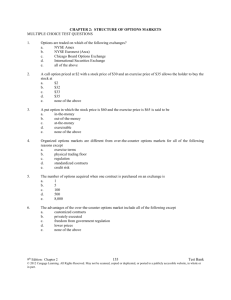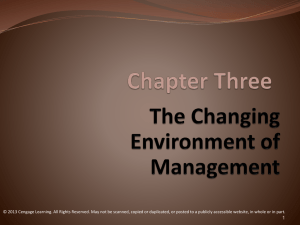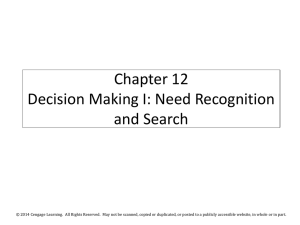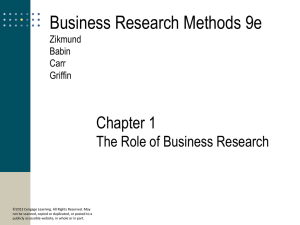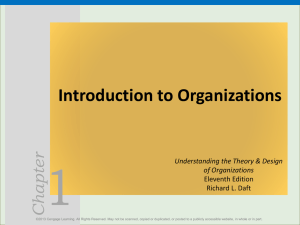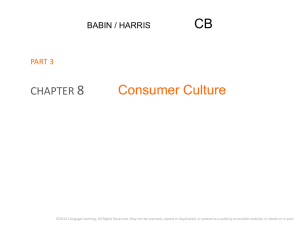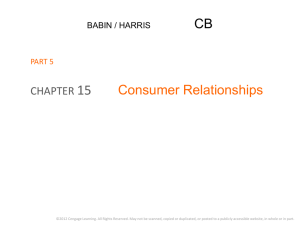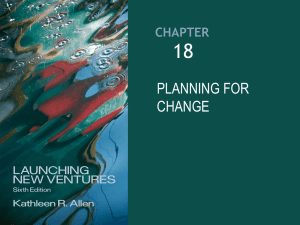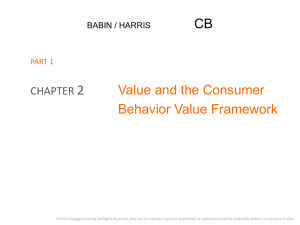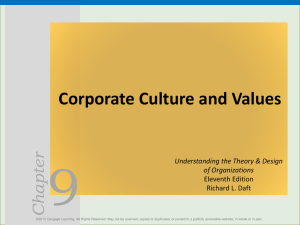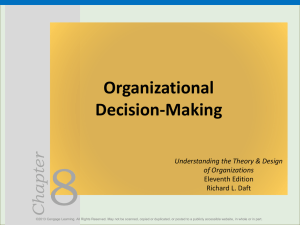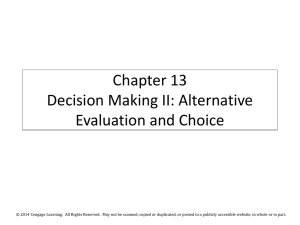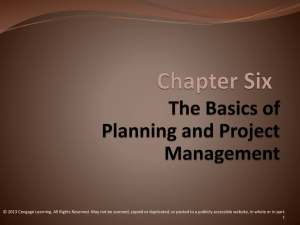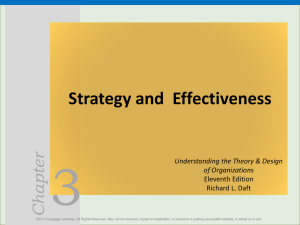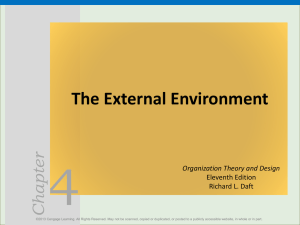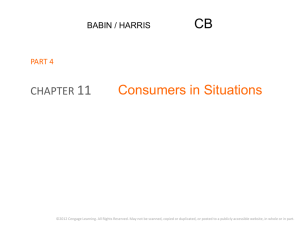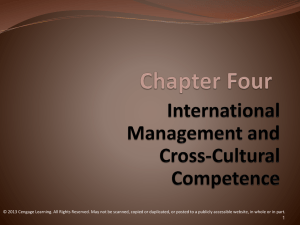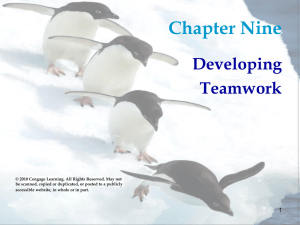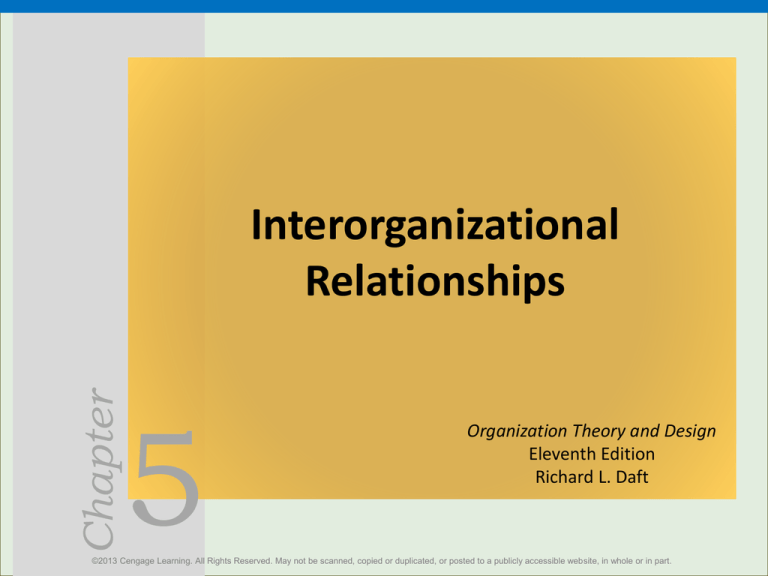
Chapter
Interorganizational
Relationships
5
Organization Theory and Design
Eleventh Edition
Richard L. Daft
©2013 Cengage Learning. All Rights Reserved. May not be scanned, copied or duplicated, or posted to a publicly accessible website, in whole or in part.
Organizational Ecosystems
Interorganizational relationships –
resource transactions, flows, and linkages
that occur among two organizations
Organizational ecosystem – a system
formed by the interaction of a community
of organizations and their environment
2
©2013 Cengage Learning. All Rights Reserved. May not be scanned, copied or duplicated, or posted to a publicly accessible website, in whole or in part.
Is Competition Dead?
• Changing technology and new regulations
present organizations with international
competition
• Organizations are involved in complex
networks; the number of corporate alliances
are increasing
• Traditional competition no longer exists
3
©2013 Cengage Learning. All Rights Reserved. May not be scanned, copied or duplicated, or posted to a publicly accessible website, in whole or in part.
Organizational Ecosystem
©2013 Cengage Learning. All Rights Reserved. May not be scanned, copied or duplicated, or posted to a publicly accessible website, in whole or in part.
The Changing Role of Competition
In ecosystems, managers move beyond
traditional responsibilities
Managers must think about horizontal
processes
The old role of management relied on
operation roles and boundaries
Collaborative roles are becoming more
important for success
5
©2013 Cengage Learning. All Rights Reserved. May not be scanned, copied or duplicated, or posted to a publicly accessible website, in whole or in part.
A Framework for
Interorganizational Relationships
6
©2013 Cengage Learning. All Rights Reserved. May not be scanned, copied or duplicated, or posted to a publicly accessible website, in whole or in part.
Resource Dependence
• Locking in resources through long-term
supplier relationships is a common resourcedependence theory
• Supply chain management refers to managing
the sequence of suppliers and purchasers
• Large independent companies can have power
over small suppliers
7
©2013 Cengage Learning. All Rights Reserved. May not be scanned, copied or duplicated, or posted to a publicly accessible website, in whole or in part.
A Basic Supply Chain Model
8
©2013 Cengage Learning. All Rights Reserved. May not be scanned, copied or duplicated, or posted to a publicly accessible website, in whole or in part.
Collaborative Networks
Emerging alternative to resource dependency
Companies join together to become more
competitive and to share scarce resources
Alliances require managers who are good at
building networks
Companies can share risk and cooperation is a
prerequisite for greater innovation, problem
solving, and performance
9
©2013 Cengage Learning. All Rights Reserved. May not be scanned, copied or duplicated, or posted to a publicly accessible website, in whole or in part.
Changing Characteristics of
Interorganizational Relationships
©2013 Cengage Learning. All Rights Reserved. May not be scanned, copied or duplicated, or posted to a publicly accessible website, in whole or in part.
Population Ecology
• Organizational diversity and adaptation within a population of
organizations
• Population is a set of organizations engaged in similar activities
• The theory notes that large, established organizations often
become dinosaurs
– They have difficulty adapting
– The changing environment determines survival or failure
• Heavy investments can limit organizational adaptation
• Model looks at organizational form
• Organizational niche can help aid in the survival of an
organization
11
©2013 Cengage Learning. All Rights Reserved. May not be scanned, copied or duplicated, or posted to a publicly accessible website, in whole or in part.
Elements in the Population-Ecology
Model of Organizations
12
©2013 Cengage Learning. All Rights Reserved. May not be scanned, copied or duplicated, or posted to a publicly accessible website, in whole or in part.
Strategies for Survival
Organizations struggle for existence
(competition)
• Generalist strategies – wide niche or domain,
broad range of products or services to a broad
market
• Specialist strategies – narrow range of goods
or services that serve a narrow market
13
©2013 Cengage Learning. All Rights Reserved. May not be scanned, copied or duplicated, or posted to a publicly accessible website, in whole or in part.
Institutionalism
• Institutional perspective:
– Manage survival
– Balance expectations of environment
• Institutional Environment
– Norms and values of stakeholders
– Adopt structures and processes to please
outsiders
• Legitimacy - an organization’s actions are
desirable, proper, and appropriate
14
©2013 Cengage Learning. All Rights Reserved. May not be scanned, copied or duplicated, or posted to a publicly accessible website, in whole or in part.
Institutional View and
Organizational Design
Technical Structure
• Day-to-day work
• Technology
• Operating
requirements
Institutional Structure
• Visible to the public
Governed by
expectations of the
public
Governed by norms
and rationality of
efficiency
15
©2013 Cengage Learning. All Rights Reserved. May not be scanned, copied or duplicated, or posted to a publicly accessible website, in whole or in part.
Three Mechanisms for
Institutional Adaptation
16
©2013 Cengage Learning. All Rights Reserved. May not be scanned, copied or duplicated, or posted to a publicly accessible website, in whole or in part.
Design Essentials
There has been an evolution in interorganizational
relationships
Organizations operate within an ecosystem
Four perspectives have been developed to explain relationships
among organizations
Collaboration is an emerging alternative to resource
dependence
New organizations fill niches left open by established
companies
The institutional perspective notes that interorganizational
relationships are shaped by legitimacy as well as
products/services
17
©2013 Cengage Learning. All Rights Reserved. May not be scanned, copied or duplicated, or posted to a publicly accessible website, in whole or in part.



